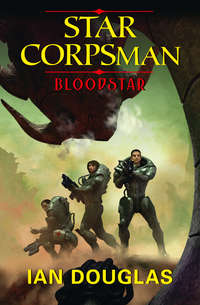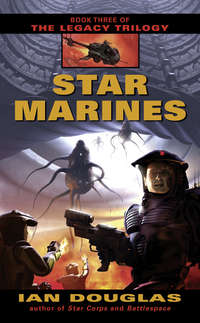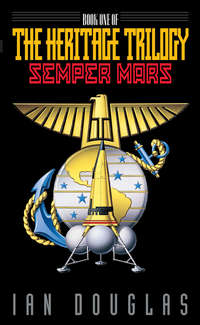
Полная версия
The Complete Heritage Trilogy: Semper Mars, Luna Marine, Europa Strike
Two of the Peregrines, moving according to plan, were making for the helipad, where they would start taking off the embassy’s civilian staff. While a third circled the compound providing gunship support, the one carrying Fuentes’s platoon would deposit them in the compound between the Residence and the front gate. They would hold the embassy until all of the civilians were away, then hightail it back for their transports and haul-tail for the Gulf of Campeche.
“Snakebite, Basket. Be advised that we have hostile MBTs and AFVs in the AO.” A side window opened on the display, showing a freeze-frame image from a military satellite, looking down onto the embassy compound. Several vehicles were highlighted by winking red dots.
“Roger that.” Tanks and troop carriers. Things were a bit more complicated than they’d expected. Just frigging great!
But then, she thought, main battle tanks were why God had invented Marine air close-ground support.
United States Embassy
Mexico City, República de
México
1521 hours local time
Bledsoe looked up as jet engines howled low out of the sky. The sheer relief, the release when he saw two Valkyrie AV-32 hoverjets sweeping low across the rooftops, sunlight glinting from their canopies, was enough to leave him weak and shaking. “Yeah!” he screamed at the sky. “Go! Go!”
The turrets of the Bradleys were pivoting to meet this new threat, but they were having trouble connecting with the targets. Vals were hard to see, even in broad daylight. Their active-camo hull coatings mimicked the surrounding colors of the sky almost as well as they absorbed radar, and with no vertical stabilizers on the flat upper surface, there was very little to catch the eye. When they dropped down low and started a head-on pass, they all but vanished, even if you knew exactly where to look.
The attack had at least distracted the Mexican troops for a few, precious moments. Bledsoe snatched at the chance, rising from his hiding place, sprinting across the scattering of sandbags, and throwing himself down across Larabee’s still form.
Larabee was still alive and breathing, though he had a nasty gash down the side of his head, and blood was pumping from a neat, round hole in his thigh, just above his left knee. Bledsoe grabbed an Ml first-aid kit and fumbled it open, extracting a sterile gauze pad and stuffing it onto the wound, trying to stop the bleeding.
Then the Bradley AFVs opened fire with their rotary cannons, hosing the sky with streams of red tracers, trying to drag down the oncoming Vals. Bledsoe never even saw the Valkyries return fire; the armored fighting vehicles simply began exploding in a quick one-two-three succession, flame and jagged black chunks of metal whirling into the air. Another blast rocked the Mexican tank. The concussions were deafening; Bledsoe covered Larabee with his own body, sheltering him as the explosions thundered and the Marine Valkyries streaked overhead.
He looked up, blinking into swirling smoke. Two more Vals were circling in the distance, as a quartet of TR-5 Peregrines angled in toward the Residence.
Time to get the hell out of Dodge. Rolling off his buddy, he gathered the unconscious Larabee into a fireman’s carry and started crawling back toward the embassy’s shattered front porch.
Rattlesnake Flight
TR-5 Peregrine transport/gunship
Mexico City, República de
México
1521 hours local time
In a swirling blast of deflected exhaust, two of the Peregrine gunships brought their noses up, tilt-jets howling as they swung to the upright, hover position, the aircraft barely moving as they drifted above the city streets in front of the embassy. A shoulder-launched rocket streaked skyward from the roof of the Sheraton; the aircraft’s active antimissile defense system, reacting with a computer’s superhuman speed, replied before the missile had traveled half the distance to the target, snapping back with a burst of radar-guided rotary cannon fire that detonated the SAM in an orange-black blossom of flame and smoke. The gunship’s main battery cut loose then, its Zeus high-speed cannon buzz-sawing into the roof of the structure with a cyclic rate of six thousand rounds per minute. Under that firestorm of depleted uranium penetrators mingled with 6.2mm high-explosive rounds and green tracers in a 7:2:1 ratio, the roof of the hotel literally disintegrated in a black cloud of whirling chips and fragments. Windows exploded, walls buckled, and much of the upper two stories of the structure crumbled into an avalanche of shattered masonry, glass, and stucco. The line of green tracers, so thick and solid-seeming it appeared to be a bright streak of dazzling green light, played briefly across the target zone, then winked out.
The tilt-jet Peregrines pivoted slowly, like hovering, airborne dragons searching for prey. Most of the mob had dispersed by now, though a number of bodies sprawled motionless in the streets or crawled slowly for imagined places of safety. Three AFVs and a heavy tank were burning in front of the embassy. A second aging M1A2 grumbled from a side street, seeking shelter from the air attacks, perhaps, but the green bolt of solid-looking flame flared once more, touching the Abrams’s turret at the engine cover. The fireball as the fuel tanks detonated roiled into the crystalline blue mountain air above the city like a black death’s-head.
The Peregrines continued to take small-arms fire from the surrounding buildings. It looked as though most of the buildings had, in fact, been occupied by Mexican troops, though the Peregrine gunners were under orders not to initiate a slaughter of Mexico City’s general population. They responded to the most serious threats, blocking incoming missiles and sending bursts of high-velocity cannon fire back at the shooters.
Enemy fire slacked off noticeably as the Mexican troops decided to stop calling attention to themselves.
Rattlesnake One
Mexico City, República de
México
1521 hours local time
Aboard the Peregrine, a red light winked on overhead. “On target,” the pilot’s voice said in Fuentes’s headset. “Opening up!” With a growling whine, the Peregrine’s aft ramp cracked open, then lowered, admitting a blaze of blue-white light from the outside.
There wasn’t room to land a Peregrine on the Residence’s front lawn. Instead, as the rear door eased open, the aircraft’s crew tossed four nylon ropes out the back; almost immediately, the first four armored Marines were fast-roping down the lines, hitting the ground hard and moving fast, clearing the area before the next man down the line hit the same spot. Fuentes followed Private Peterson, stepping off the ramp and sliding down the rope with practiced ease. The ride down was dizzying, with the Peregrine hanging like a vast, black whale just above their heads, the tilt-jets shrieking to left and right like demented banshees.
Fuentes landed with pile-driver force, nearly sinking to her knees, but then she was diving ahead, getting clear before Gunny Walsh landed on her shoulders. She didn’t remember slapping the release on her M-29, but her rifle was in her gloved hands and the liquid-crystal readout on the stock showed a full load of one hundred rounds, ready to rock and roll. She didn’t see any immediate targets; a Mex tank was burning cheerfully in a smashed-out gap in the compound wall to her right; the smoking, flame-blackened shells of a trio of Bradley AFVs were scattered along the embassy’s front drive farther on.
Near the front door of the embassy, she saw one Marine crawling with another man slung across his back. “Bellamy! Kelly! Sanderson!” she snapped off. “Deploy right! Hold the wall! Gunny! Take the others! Form a perimeter covering the main drive and the front of the building!” Fuentes double-timed it across the lawn, reaching down to help the Marine with his wounded buddy. Both men were hurt, one unconscious with head and leg wounds, the other with blood smearing his face and the dazed look of someone caught too near an exploding round.
Another Marine appeared beside her, tall, lean-faced, with a captain’s bars in dull black metal showing on his fatigue collar. WARHURST, T. was stenciled on his black combat vest. He helped her lift the wounded men and drag them toward the Residence. “Good to see you, Lieutenant,” he said.
“Sir, Lieutenant Fuentes reporting,” she told him. “First Platoon, Alfa Company. What’s your situation?”
“We’re okay now,” he said, as more embassy Marines spilled out of the building and took charge of the two wounded Marines. He turned then to face her. “Now that you and some Marine air are here. They came over the wall three or four minutes ago…civilians, at first, or at least men in civilian clothing.”
“A setup, you think?”
Warhurst nodded. “Definitely.” He held up his hand as though spreading out a newspaper headline. “‘US Marines Slaughter Helpless Civilians at Demonstration outside Embassy.’ It’ll look great on Triple-N. Especially in Geneva.”
She gestured toward a burned-out Bradley with her ATAR. “Civilians don’t usually attack embassies with tanks or AFVs.”
“Mmm, no…but they’ll say they sent in the army to restore order. I doubt that anyone will question why the army just happened to have an armored division parked across the street when the trouble started.”
Fuentes felt herself go ice-cold inside. She’d been responding to a provocation, following orders, even fighting the first battle of a war…but she’d not thought her actions could have possibly been construed as starting that war.
Gunfire continued to pop and crackle in the distance, but the area around the embassy was eerily calm at the moment. God knows what they’re shooting at, she thought. Or why. Alien cultists, possibly, exchanging pleasantries with anti-alien religious fanatics. The whole world had been coming unglued lately. Maybe all that had been needed to smash it apart was this one, last, tiny nudge.
A roar from the roof of the embassy signaled the first of the TR-5 transports lifting clear, hovering a moment, then dipping its nose and banking toward the east. An AV-32 followed, flying shotgun.
Warhurst touched the radio plug in his right ear, listening. “Okay,” he said. “Roger that.” He looked at Fuentes. “The ambassador and his family are away. Most of the civilians, too, and our wounded. Now we just have to get ourselves the hell out of here.”
The evacuation proceeded smoothly, with a choreographed precision that seemed to have been carefully rehearsed. The remaining civilians, the embassy’s CIA staff, and the rest of the embassy Marines made it off in the second TR-5. Warhurst helped get them all on the tilt-jet before it lifted off and followed the first toward the east and safety, but he remained behind on the roof to see to the evacuation of the First Platoon Marines.
At Fuentes’s signal, the last of her Marines outside the Residence fell back from the walls, filing inside the shattered building and making their way up the steps. Fuentes found Warhurst standing on the embassy roof. “Come on, sir!” she yelled. “Last plane out of this burg!”
Something had caught his attention on the grounds below, and he unslung his M-29. “Get the rest of your people on board,” he said. “We have company.”
She joined him at the parapet, staring down into the front of the compound. Under cover of the dense smoke, more vehicles had moved close to the embassy walls, and dark-uniformed troops were scrambling out and spilling into the embassy grounds through a dozen different breaches.
“Now I know how Davy Crockett felt at the Alamo,” he told her.
“Let’s get out of here, sir!”
“You go. I’ll—”
“Come on, Captain! Now!”
He nodded. “Okay! Go! Go!”
First Platoon’s Peregrine was loading on the embassy roof now, with Sergeant Walsh hurrying the last few men across the helipad pavement to the waiting tilt-jet. Together, Fuentes and Warhurst sprinted for the aircraft. The engine whine was spooling up, the air above the pavement dancing and shimmering in the jetwash.
Fuentes had reached the TR-5, pounding up the lowered rear ramp before she realized that she was alone. “Where is he?”
Walsh looked about, then pointed. Twenty meters across the helipad, a small shed rose from the embassy roof, a shelter for the stairwell leading down into the building. Warhurst had positioned himself next to the open door and was leaning over the stairwell, firing his M-29 down the steps at unseen attackers.
Fuentes saw what must have happened. While the last of the Marines had been loading onto the transport, Mexican troops had raced into the embassy and come swarming up the stairs. Warhurst had known they were there already, or guessed it. He stood now on the landing, exchanging fire with the Mexican troops, keeping them from emerging onto the helipad.
“Captain!” Fuentes yelled. Her voice was lost in the roar of the engines. Biting off a curse, she touched her Motorola’s transmit switch, choosing the command channel. “Captain!” she yelled again. “Come on! We’ll cover you!”
“Roger that!”
Loosing a final long burst of gunfire down the stairwell, Warhurst turned and started running toward the Peregrine. He’d only come about three steps, however, when an explosion ripped the red metal door from the stairwell shed and knocked the Marine captain flat.
Fuentes started back down the ramp. Warhurst saw her and waved her back. “Get away!” She heard his voice over her transceiver. “Get the hell away!”
A machine gun opened fire from the roof of one of the neighboring buildings, striking sparks from the pavement between Fuentes and the downed Marine, smacking into the Peregrine with a chilling, metallic thunk-thunk-thunk. Instinctively, she dropped, searching for a target. The machine gun kept firing, aiming for the transport.
“We’re taking hits!” the Peregrine’s pilot called over her earpiece. “We’re taking hits! We’ve got to go!”
“Go! Go!” Warhurst shouted. “That’s a goddamn order!”
Mexican troops burst from the smoking stairwell shed, firing wildly. She saw Warhurst rolling over, saw him fire into the charge, saw him go under. Sergeant Walsh dragged her up the ramp as the pavement dropped away beneath her. The TR-5 was airborne, boosting itself into the sky as gunfire probed and chattered after it.
“You couldn’t have gotten to him,” Walsh told her.
“Damn them!” she yelled, battle lust and horror and frustration and rage all boiling from her in a nightmare of raw emotion. “Damn them!…”
One hundred feet above the embassy, the Peregrine’s pilot banked the aircraft slightly, giving the Zeus gunner a clear field of fire. For three or four seconds, a solid line of tracers, like straight, hard, green lightning, licked at the embassy roof, smashing into and through the structure in a cataclysm of detonating HE rounds and depleted uranium penetrators. Fuentes, still watching from the half-opened ramp of the aircraft, saw dozens of troops trapped in that deadly beam, transfixed, then torn apart and scattered by that searing whirlwind of death and utter destruction.
The embassy roof, what was left of it, collapsed in flame and boiling smoke.
We never leave our own behind….
But she had. Damn it, she had….
SIX
SATURDAY, 12 MAY
Earth-Mars Cycler Polyakov
1417 hours GMT
“All right, people!” Colonel Lloyd bellowed. “Listen up! We got us a major change of plans, here.”
Lloyd waited as the buzz of speculation and grumbling died away. Most of the MMEF’s Marines had been gathered in Polyakov’s storm cellar, in full Class-One armor, with weapons and HUD helmets. Those not mustered in were watching through the unwinking eye of the television camera mounted on the bulkhead.
“What kind of change, Colonel?” Sergeant Ken Jacob called out.
“Yeah,” Corporal John Donatelli added. “We gonna get to go kick ugly space-alien butt or not?”
The others chuckled, and several gave one another gloved high-fives.
“No, but I’m gonna kick some ugly Marine butt if you assholes don’t simmer down.”
James Andrew Lloyd knew he had a reputation for being hard on the men and women under his command. In fact, he gloried in that rep, cultivating the image of a hard-as-nails badass the way other men cultivated wealth or success. It had been that way for as long as he could remember. The United States, nearly a century after the Civil Rights Act of 1964, guaranteed equality for all…but there was still that unspoken assumption, strongest in the black, middle-class families like the one James—never “Jim”—had grown up in, that blacks and women had to work extra hard, had to go that extra kilometer, just to prove that they really had what it took.
James Lloyd had been taking that extra kilometer for a long time, now. Hard work and a no-nonsense attitude had led to his graduation cum laude from the University of Michigan, followed by both OCS and Marine Aviation Flight School. He’d flown a Harrier IV in Cuba in ’24, led a platoon by airdrop into Colombia in ’27, and seen combat since in Panama, Greece, and Andhra Pradesh.
While the fact that he was black had helped define his career, he rarely thought about it now. The Marine DI who’d run his OCS class had been black; an oft-quoted motivational expression of his was an old Corps theme: “There are no black Marines. There are no white Marines. There are only amphibious green Marines…and right now I want to see nothing but amphibious green blurs!…”
Colonel Lloyd thought of himself as amphibious green.
“Our original mission profile,” he told them as the noise died away, “called for off-loading to a Mars Shuttle-Lander, followed by a descent to the primary base at Candor Chasma. Those of you who’ve read your mission profiles—maybe I should say those of you who can read—know that Candor Chasma is on the Martian equator…about five thousand kilometers from Cydonia, which is where we’re ultimately supposed to be deployed.
“A new set of orders has come through from Earth, however. The MSL pilot has been ordered to take us directly to Cydonia. The bulk of our supplies and matériel will be sent to Candor Base, as originally planned. We will take with us what we can ferry along in the one MSL.”
“Aw, shit, Colonel!”
Lloyd turned a hard gaze on the Marine who’d spoken. “You have a problem with that, Corporal Slidell?”
“Sorry, sir…but damn it, what about all our supplies and shit?”
“There is no effective difference in the new deployment,” Lloyd said patiently, “at least insofar as our equipment is concerned. We would have had to off-load our gear at Candor, then repack what we needed to carry along aboard another MSL and redeploy by suborbital hop to Cydonia. As we needed spares or whatever, they would have been sent to us on the regular supply runs. We’re just cutting out one extra hop for us.” He studied Slidell’s stricken face, wondering what was going through the man’s head. “Be happy, Slider. The lot of you would’ve spent a day or two unloading shipping containers at Candor. Instead, you all get to sit on your fat, happy asses, guarding sand dunes at Cydonia.”
“Yeah, but it ain’t fair, jerkin’ us around like that,” Slidell said.
“Easy, man,” Lance Corporal Ben Fulbert told Slidell. “Ice down.”
“The Corps never promised you fair, Slider.” Lloyd decided that he would have to keep an eye on the man. He seemed just a little too upset by the change in plans.
“Why the change, Colonel?” Staff Sergeant Ostrowsky wanted to know. “I thought everything had to channel through Mars Prime.”
“When they tell me, Ostrowsky, I’ll tell you. In the meantime, we follow orders.” He hesitated before adding, “Let’s just say that HQ is concerned about the friendliness of our reception. So we go in sharp, and we go in with Class-Ones. Questions?”
There were plenty of questions—there had to be with this crowd—but no one spoke up. Hell, he had questions, and none of them could be answered yet.
The change had come through only a few hours before, coded, and marked Secret and Eyes Only. INTEL BELIEVES UNFMC TROOPS SHIFTED TO MARS PRIME REGION LAST 72 HOURS, the report had stated. The United Nations Force, Mars Contingent, numbered fifty men, almost twice the number in Lloyd’s Marine platoon. If they’d shifted south from Cydonia to the Mars Prime base at Candor Chasma, it could be because they planned to confront the Marines when they landed.
Or possibly not. Bergerac, the UNF’s new CO, was aboard the Polyakov. Maybe they were just getting ready to throw him a welcome-to-Mars party.
But Lloyd firmly believed that a little healthy paranoia was good for a man…and especially for Marines who planned to die in bed. That was why he’d ordered the platoon to assemble here in full armor, complete with weapons, HUD helmets, and full field gear. It made the storm cellar a bit crowded, and the deorbit was gonna be hell, but at least they would be ready, no matter what was waiting for them on the ground.
“Okay, people,” he said at last. “We got thirty mikes before the shuttle docks. Time for weapons drill.” He looked at his wrist-top, which had been attached to the outer sleeve of his gauntlet. “Ready…begin!”
Half an hour later, on schedule as dictated by the dead hand of Sir Isaac Newton, the first of a small fleet of approaching Mars Shuttle-Landers docked with Polyakov’s nonrotating hub. Though there were no windows in the storm cellar, there was a small television monitor with a feed from the control deck, and Lloyd was able to open a channel from one of Polyakov’s docking-bay approach cameras.
Harper’s Bizarre—painted in grit-scoured red letters on the stubby craft’s bare-metal prow—was the unofficial name of the first of the MSLs that slowly eased in to a capture and hard dock. The upper half of the forty-meter craft was a biconic hull, an off-center cone designed for atmospheric reentries, while the lower half consisted of two, stacked doughnut-clusters of spherical methane tanks and the close-folded complexity of a trio of spidery landing legs. The Bizarre, like the other MSLs on Mars, was a nuke, using a Westinghouse-Lockheed NTR, a Nuclear Thermal Rocket similar to the old Nerva designs, to heat the tanked reaction mass. The propellant of choice was methane, a liquid produced in quantity on Mars from atmospheric CO2 and permafrost-melted water; the concept was known as NIMF, an unlikely acronym standing for Nuclear rocket using Indigenous Martian Fuel.
Once the green light showed for docking lock one, pressures were equalized and the MSL opened to Polyakov’s interior. As befitted one of the burgeoning Martian colony’s workhorses, the Bizarre had a large and utilitarian cargo section, which for this trip had been fitted with a plug-in deck-chair module. Nothing fancy, but it had padding and straps enough to get human cargo from the cycler’s orbit to the Martian surface in, if not comfort, then at least relative safety.
Lloyd’s path through the docking collar and forward pressure lock brought him to a point where he passed beneath the feet of the MSL’s pilot. “Marine Mars Expeditionary Force,” he rasped out. “Request permission to come aboard.”
“Granted, Colonel,” the pilot called back. She was a slender redhead in a trim, lightweight pressure suit. “Find yourselves seats and get strapped in.”
The rest of the Marines were already clambering in after him, muttering curses or sharp imprecations as their clumsy Class-Ones scraped or bumped against equipment, bulkheads, or the armor of other Marines. Class-One armor was almost as bulky as a full-fledged space suit, and with good reason. It was self-contained, pressurized, and—with a full-charged life-support pack and rebreather assembly—could keep a man alive in hard vacuum almost indefinitely…or at least until his food ran out.
All of the MMEF’s armor had active chameleonic surfaces—coatings of a specially formulated plastic that “remembered” incident light and was able to adapt its color and texture within minutes to match the surroundings. The only parts of the suits that did not sport this constantly shifting surface were the helmet visors—normally dark to block ultraviolet radiation—and the traditionally camouflaged helmet covers. Those last were something of an old Marine tradition, a holdover from the second half of the twentieth century. Marine aviators, though they’d worn flight suits and standard helmets when they’d gone aloft in their old Harrier IIs or F/A-18s or, later, in their F/A-22s and AV-32s—always wore the US Marines’ standard tan, brown, and green fabric helmet cover…not for camouflage, but to show solidarity with their fellow Marines on the ground. It was a tradition that went back at least as far as Vietnam, and probably farther; Marines took extraordinary pride in the close relationship between Marines in the mud and the Marine aviators flying close support.









